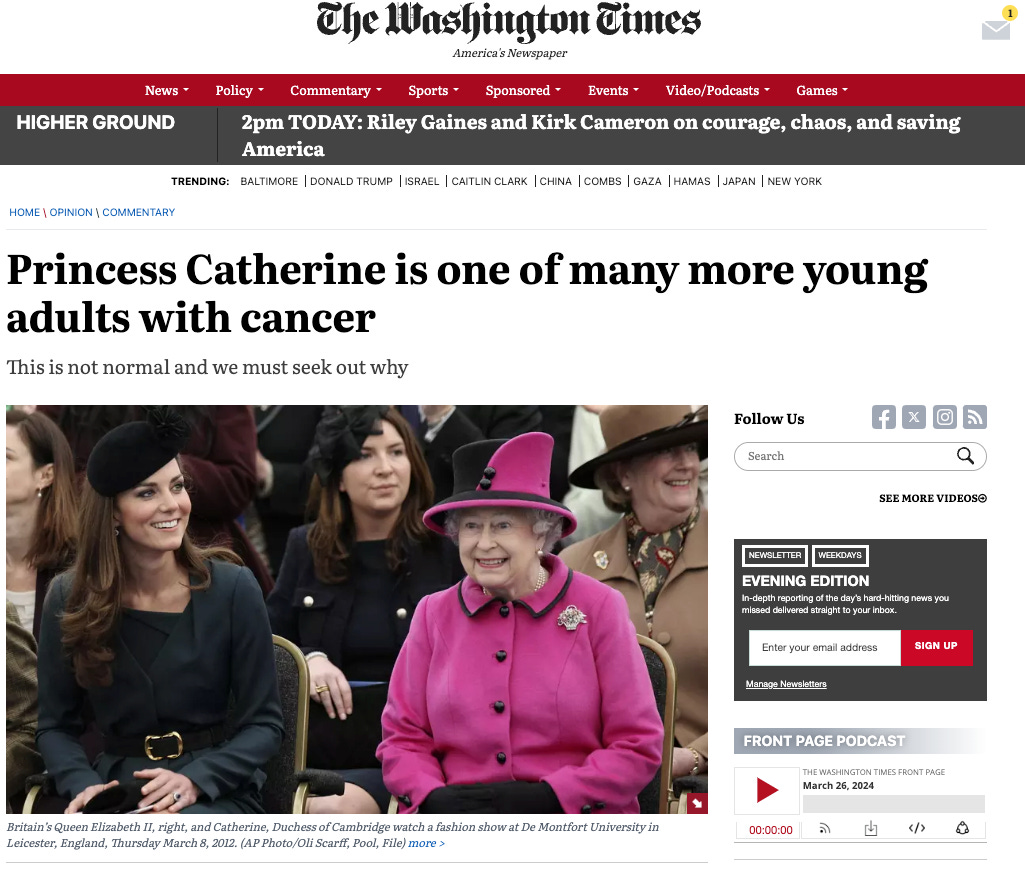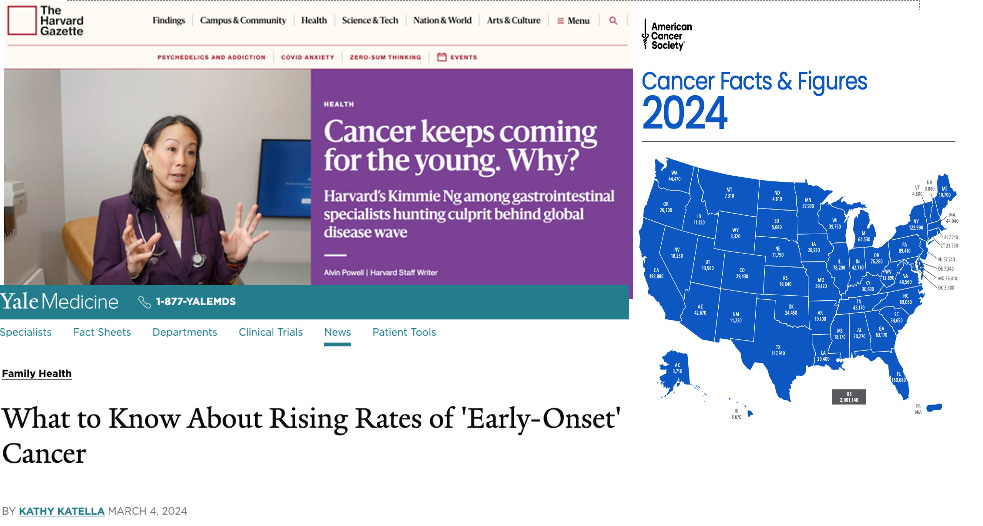We Published An Op-Ed On The Unprecedented Rise In Cancer Among Young People And Questioned The Link To mRNA Vaccines

Investigative journalist Mary Beth Preiffer and myself, helped by actuarial expert Mary Pat Campbell, published an Op-Ed about the recent alarming rise in cancers among young people like Princess Kate.

We have now published three Op-Ed’s on the excess mortality and disability rate spikes which have occurred subsequent to the Covid mRNA campaign (and particularly its mandates) in USA Today, Newsweek, and The Hill. We also published an Op-Ed on the massive surge in maternal mortality in 2021 beginning right after mRNA vaccines were widely recommended to pregnant women (with almost no safety data) by the American College of Obstetrics and Gynecology and the CDC.

It gets worse. As an “awake” clinician on the front lines, I had been reading reports of innumerable young people (often famous) repeatedly contracting and dying from cancer (Dr. William Makis’s Substack has best compiled these reports – like this one, this one, and this one among others). I have also been deluged with more direct reports of cancer befalling young people amongst my ever-expanding network of friends, colleagues, patients, and contacts.
Many have been noticing new cancer diagnoses amongst their friends and relatives, with the majority occurring amongst people younger than is typical for cancer. Further, the cancers appear more aggressive given reports of death within just a few short months (or even weeks) after diagnosis.
It is so bad that it is now even being alarmingly remarked on by Yale, Harvard and the American Cancer Society (but of course none ever mention any possible link to the mRNA campaign).
One of the most shocking pieces of data supporting the new reality (and medical term) of “turbo” cancers is this one:
In the CDC data, there is a category called “all other and unspecified malignant neoplasms,” meaning cancers that had spread to the point that their origin was not identified before death. Across all ages, they rose 11% from 2019 to 2023. Now consider that these deaths rose 18% among 35-to-44-year-olds and 16% among 5-to-14-year-olds in that period.
It is even being remarked on by the Cancer Society:
“Colorectal cancers are also presenting with more aggressive disease and larger tumors at diagnosis,” said William Dahut, the American Cancer Society’s chief scientific officer, after the report’s release. “It’s more difficult to treat,” he told NBC News.
Tell me about it. Just a few weeks ago, a 20 year-old patient of mine died of glioblastoma. If that is not tragic enough, her parents told me that a 20 year-old man in her college friend group had died of the same a few weeks earlier. Unsurprisingly, their university had a vaccine mandate. Just a tragic coincidence right?
Bearing witness to so much medical carnage, and knowing with near certainty the proximate cause, we worked for weeks trying to compile and interpret data from government and professional society sources. As above, we found that what is happening with cancer in young people is not anecdotal and is instead real and supported by the data.

Further, we believe that the data strongly if not definitively implicates the covid mRNA vaccine as the most proximate cause and so we wrote an Op-Ed trying to alert the general public to yet another catastrophic consequence of the mRNA campaign. In a small win against the pervasive scientific censorship around adverse vaccine data, we were able to posit that hypothesis in our piece.
We just refuse to “stand by idly” while so many are dying around us.
COMMENTARY
By Dr. Pierre Kory and Mary Beth Pfeiffer – – Tuesday, March 26, 2024
OPINION:
It is called early onset cancer. And the Princess of Wales, diagnosed at 42, is part of an unfortunate new trend of more and younger cancer cases.
Yale, Harvard and the American Cancer Society each weighed in recently on this unthinkable twist in the toll of cancer. A record 2 million people in the United States will suffer malignancies this year, the society said, and a larger share of the 600,000 to die, they agreed, will be younger than before.
This marked a sea change in the cancer message. In 2023, the Cancer Society’s previous annual report focused on 29 years of cancer progress tempered by racial disparities in survival.
But the 2024 report was different. Colorectal cancer moved as of 2021 to the leading cause (from fourth) of cancer death in men under 50, the report said, and second for women. Young adult oral and liver cancer deaths were increasing, along with deadly cervical tumors in women ages 30 through 44, reversing “decades of decline.”
We looked at the Centers for Disease Control and Prevention’s cancer death records through 2023, two years beyond the Cancer Society report. The later data, which is provisional, shows a cancer pattern that appears to have gone from slow simmer to rapid boil in the heat of a pandemic.
Across all ages, cancer deaths rose by 2% from pre-pandemic 2019 to 2023, we found. But in people 15 to 44 years old, mortality rose at double that, to 4%. Why is this happening now? Moreover, what will be done to address it?
Among the red flags: Deaths from colorectal cancer rose 17% among those 15 to 44 in that time, four times the population-wide increase. Uterine cancer deaths rose 37% among 25-to-44-year-olds from 2019 to 2023; they rose 15% overall.
We also saw much larger increases, from 2019 to 2022, in liver and pancreatic cancer mortality in young adults than in the overall population. There is fodder enough here to ask if these are aberrations or harbingers.
Especially troubling is the presentation and rise of young colorectal cancer. Harvard medical professor Kimmie Ng said the “steepest rises” are “in the very youngest people, those in their 20s and 30s,” which another cancer expert called “alarming.”
“Colorectal cancers are also presenting with more aggressive disease and larger tumors at diagnosis,” said William Dahut, the American Cancer Society’s chief scientific officer, after the report’s release. “It’s more difficult to treat,” he told NBC News.
Sean Stone, a 31-year-old American actor and producer, was one of these cases. He died March 7, just seven months after he was diagnosed with metastatic colon cancer. We can no longer dismiss such cases — and there are many — as isolated anecdotes.
In the CDC data, there is a category called “all other and unspecified malignant neoplasms,” meaning cancers that had spread to the point that their origin was not identified before death. Across all ages, they rose 11% from 2019 to 2023. Now consider that these deaths rose 18% among 35-to-44-year-olds and 16% among 5-to-14-year-olds in that period.
Click this link to read the rest of the Op-Ed.
• Dr. Pierre Kory is president and chief medical officer of the FLCCC Alliance. Mary Beth Pfeiffer is an investigative reporter and author.
Originally published on the author’s Substack
One of our country’s most important freedoms is that of free speech.
Agree with this essay? Disagree? Join the debate by writing to DailyClout HERE.




